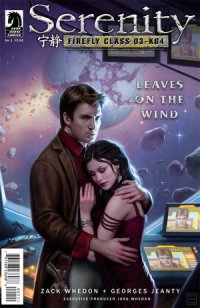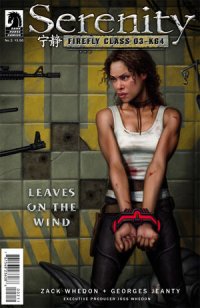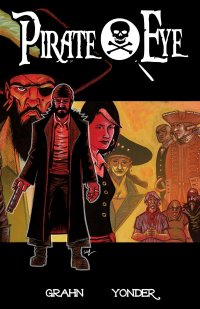Serenity: Leaves on the Wind #1 & 2 (Dark Horse, $3.50)
By Adam X. Smith
Turns out I wasn’t the only one who found “Season Nine” of the Buffy comics a bit of a drag – while well placed mini-series for Spike and Willow kept me entertained early on, I found myself zoning out roughly halfway through, and didn’t even start on Angel & Faith (despite the overall plot sounding kind of intriguing). Sadly, the book which I had followed if not religiously then certainly with vigour in “Season Eight” was slipping down my priorities list.
Part of it is the fact that Joss Whedon is once again settling back into an “executive producer” role – a term which is getting tossed around a little bit too liberally in comics these days – rather than being the book’s sole or primary writer, with the likes of Andrew Chambliss and Christos Gage picking up the slack, which given his workload is hardly surprising or unwarranted. Another part however is the fact that the book’s long-term artist, Georges Jeanty, was slowly but surely losing his edge on the art front. Maybe it was a run of particularly poor inking, maybe it was the rigours of getting the book out on time – whichever it was, it was a poor run for an artist who I knew was better than what they were putting out there. And that’s something no critic likes to say about someone they admire.
It’s a welcome surprise, then, that Serenity: Leaves on the Wind is exactly what the doctor ordered. Jeanty’s artwork pops in a way I’ve not seen since the halcyon days of “Season Eight”, and Zach Whedon does a pretty decent job at approximating the style of his elder brother.
 Picking up roughly nine months after the events of Serenity, the Alliance is still looking to silence River, an occupy-style band of resistance members are looking for a leader in the form of Captain Mal Reynolds, and the Firefly crew are hiding out in the middle of nowhere with dwindling resources and a pressing need to eat. However, when a heavily pregnant Zoe suffers complications giving birth to the late (and much-missed) Wash’s daughter Emma, they are forced to make a break for the nearest hospital ship with the understanding that the feds will almost certainly capture them.
Picking up roughly nine months after the events of Serenity, the Alliance is still looking to silence River, an occupy-style band of resistance members are looking for a leader in the form of Captain Mal Reynolds, and the Firefly crew are hiding out in the middle of nowhere with dwindling resources and a pressing need to eat. However, when a heavily pregnant Zoe suffers complications giving birth to the late (and much-missed) Wash’s daughter Emma, they are forced to make a break for the nearest hospital ship with the understanding that the feds will almost certainly capture them.
Naturally, the jump in quality of the work here is visible but not unwelcome. After all, this is not brother Zach’s first space rodeo, having written a handful of Serenity-themed comics previously, and even though the script tends to rely a little too heavily on catchphrases it never degenerates into lazy fan-fiction. Likewise, Jeanty is self-evidently a fan not just of Firefly but science fiction in general, and it’s a feather in his cap that the genre suits his style of drawing. Admittedly, some of the characters suffer a little from a lack of heft, in the same way that his Buffy characters can occasionally, but his obvious joy at being able to play with characters from the show – in particular one old nemesis – is evident throughout.
So yeah. The Firefly crew are back, and they’re big damn heroes. Looks like you really can’t stop the signal after all.
Issue #1 & 2 Rating: 




Out of a Possible 5 Stars
ALTER-EGO #5 (Heroic, $4.99 print format, $0.99 digital format)
By Cat Taylor
Since joining the Thor’s Comic Column review staff here at CHUD, I have had the pleasure of being exposed to a healthy amount of independently produced digital comics that I wouldn’t have otherwise known about. In turn, when I find something interesting I enjoy helping to expose it to a larger market. However, I have recently realized that frequently when a book is a new arrival to our main source of digital comics, Comixology.com, it has already been available elsewhere for over a year. Case in point is Alter-Ego #5, which first saw print in March 2012 but is newly available at Comixology.com. So, while this may be old news to a few hardcore comic collectors, I feel pretty confident that it’s new to most.
The story of how Alter-Ego #5 came into existence is a fairly long one but the high points are as follows. Back in the 1980s, an independent publisher called First Comics made a small impact as one of the more successful independent publishers of the time. They managed to release a few minor hits and attracted some top tier talent. Among this talent was the legendary writer, Roy Thomas. Thomas had a bit of nostalgia for World War 2 era comics and sought to pay tribute to them with the stylistically similar Alter-Ego. Rather than simply doing a Captain America Comics knock-off, Thomas wrote his story about a teenager in the modern world who gets sucked into his grandfather’s old comics and lives out the adventures within those four-color pages as a costumed crimefighter known as Alter-Ego. The series ran for four issues before being cancelled. Many years later, Thomas had the opportunity to produce the fifth issue of his series for another lesser known independent publisher called Heroic Comics. With all the time that passed, Thomas didn’t want to write just another regular issue of his series but instead decided to pay tribute to another genre that was popular in the World War 2 era, crime comics. The result was this very issue.
Although the main intent is to pay tribute to the crime comics’ genre, Thomas’s use of the established Alter-Ego series makes the story feel a bit schizophrenic. In order to work a new genre into the series without completely changing the main characters and their universe, Thomas has the character of Alter-Ego pulled into a crime comic rather than his old superhero comics. Ultimately, this results in the story feeling disjointed as Thomas tries to shoehorn what was previously established into a crime comics tribute. Although the main character detracts from the crime comic feel by pulling too much of the focus to him being a fish out of water, there are a few other little touches that give the story a bit of retro fun. For instance, in his “real world” identity, Alter-Ego discovers that one of his old superhero comics is missing and has been replaced with a crime comic. He is confused about how he came to own a mid-issue of a crime comic series until he reads the comic’s small print credits to discover the series has been renamed to reflect the crime comic genre but continued with the original numbering. This was a common practice long ago, whereas nowadays publishers just start a new series or cancel the series and start it again with a new first issue as often as possible. In addition, Thomas includes cameo appearances by several old WW2 era comic characters. You’ll likely recognize many of them from Project Superpowers or similar titles. However, a lot of the characters’ names have been changed to prevent copyright issues. For instance, the original Daredevil is called Double Dare in this series, which is a much better name than some of the other revisionist names that have been used for this character like Red Devil or simply ‘Devil. Finally, Thomas and artist, Ron Harris, have also included their version of the old True Crime Comics spectral icon, Mr. Crime. He is called Brother Crime here but he is otherwise almost identical to the original character. Speaking of the artist, I don’t feel like his style really captured the visual look of the old crime comics, but instead his work looks like the classic superhero art of the 1980s. For the 1980s’ superhero style, it’s excellent. The panels show a lot of energy, are clean and detailed, and burst with color.
While I like that this comic is treading some uncommon ground for modern comics, any time the primary objective of a story is nostalgia, a reader has to really love the genre as much as the writer to make it worthwhile. Since I’m far too young to have nostalgic feelings for the WW2 era crime comics, I find those kinds of comics to be overly simple and kind of boring. In this case, mixing in the old Alter-Ego concept really didn’t help and actually mired the story down with exposition necessary to catch up new readers on the old concept. Regardless, there are a lot of people whom I firmly believe will enjoy this much more than I did. So, I wanted to give Alter-Ego #5 some attention for a nice effort that needs to find its fans.
Rating: 




Out of a Possible 5 Stars
 Pirate Eye Volume 1: Wretched Tales (Action Lab, $11.99)
Pirate Eye Volume 1: Wretched Tales (Action Lab, $11.99)
By Jeb D.
In a recent review, I made note of the current popularity of placing 21st century storytelling tropes into historical settings, with the result that characters who think and speak with an awareness of modern ethics and societal mores get awkwardly shoehorned into period costume and environments. One of the properties that I cited was the Starz TV series Black Sails, which features recognizably modern perspectives on matters of race, gender, and class, in a classic “pirates of the Spanish Main” setting. Little did I realize that Action Lab had beaten them to it a year or so ago when they launched an even more audaciously absurd genre mashup: dropping a classic hardboiled post-WWII detective into that same historical setting.
I have to give writer Joe Grahn credit for the sheer boldness of his concept, though I’m often less convinced by the execution. It’s hard to know just how much interest (if any) Grahn has in the crazy quilt of anachronisms that result from his placing a mid-20th century archetype against an 18th century backdrop with a 21st century perspective; for better or worse, the reader has to quickly either accept the appearance of phrases like “lightweight” (as a dismissal of a nobleman who can’t hold his drink), “This is me on the job,” “Talk amongst yourselves,” or “What’s with him?” and either roll with it or not. Most of the setpieces and characters are more familiar from detective stories than pirate ones (the femme fatale, the corrupt authority figures, the scenes of our hero tossing smartass comebacks while henchmen work him over), and they’re often fun, even when they don’t blend particularly well with their setting.
Grahn also does himself no favors by the curious choice to name his protagonist “Smitty”; yes, there’s a reason (his typically dark backstory includes having once been a silversmith), but it’s an equally odd, diminutive, name for either a pirate or a PI, and is another choice that tends to pull the reader out of the story. Ultimately, we find ourselves reading more to see what sort of spin Grahn’s going to put on the genre clichés he’s repurposing, than with any actual investment in what’s happening with the characters.
Like Black Sails, Pirate Eye suffers a bit from being awfully talky relative to your typical tale of blood and plunder on the high seas; some of that, of course, comes with the territory for a detective story, where much conversation will be devoted to alibis, motives, prying out buried secrets, etc. Fortunately, this plays to the strengths of artist Carl Yonder (no, I have no idea if that’s his real name): a lot of this volume is devoted to scenes of our buccaneer “gumshoe” meeting with clients, witnesses, and suspects in gloomy, candle-lit environments, and Yonder takes the opportunity to cast a dark mood over the proceedings that edges more toward Spillane than Sabatini.
Structurally, this volume collects a series of one-shot stories which evoke the short, punchy pulp-era writing that launched the careers of writers like Hammett and Chandler; they all eventually graduated to novel-writing, allowing them more opportunity for texture and depth, and I could see Pirate Eye developing along the same lines. Smitty’s never going to pass for a “real” pirate, but then most of what we “know” about the pirate lifestyle comes from some highly suspect sources anyway*, so I can roll with the idea of this highly modern character investigating the dark corners of what is, in effect, a fantasy world, anyway. Basically, if the idea of Grahn and Yonder’s little genre experiment appeals to you, you should find this series of interest, but if it all sounds a bit coy and gimmicky to you… well, it’ll probably read that way, too.
*The 1724 book “A General History of the Robberies and Murders of the Most Notorious Pyrates,” which is the principal source for most of our received impressions of the best-known pirates and their lifestyle, was written by the pseudonymous “Charles Johnson,” whose real-life knowledge of the details of the pirate life is highly suspect; in other words, he was probably a writer who made a lot of shit up.
Rating: 




Out of a Possible 5 Stars
AKI ALLIANCE graphic novel (Ryanestrada.com, $1.99, or free on the creator’s website)
By Cat Taylor
Here’s another book that’s been out for a very long time (since 2011) but is making its Comixology debut and therefore is brand new to me. The series writer, artist, and publisher, Ryan Estrada went all out by releasing this as a 200 page graphic novel rather than as a maxi-series of shorter issues. Of course, when you’re working digitally and independently, the standard market wisdom is moot.
The basic plot of Aki Alliance, is that the main character, Aki, has made everyone in her class mad at her because she has joined and quit every club in school and doing so has left the remaining members holding the bag on a lot of things Aki set in motion but abandoned. One of her classmates bets Aki that she can’t make friends with everyone in her class by graduation. Aki accepts the challenge with some very entertaining and overly complicated plans to win the bet as she works her way through scenarios worthy of TV sitcom absurdity but which are much more interesting and funny. For instance, the first example of such involves Aki playing in a Scrabble tournament while trying to coach one of her classmates through a boxing match via headsets. During the course of the book, Aki demonstrates her self-centeredness and cluelessness about what it means to be friends. However, this is not done in a heavy-handed or otherwise moralizing way. Instead, it’s one of the comical elements that adds much of the entertainment value to the story.
Aki Alliance is one of those fun little books that can be a light-hearted children’s story for smart, young teens but is also clever enough and has enough “Easter eggs” for adults to enjoy as well. One of those Easter eggs is the cover image of Aki holding a black and white class photo with red Xs over the faces of several of her classmates in homage to the cover image for Battle Royale. However, the children’s cartoon art style should readily reveal that this is not a violent or graphic story by any means. As is revealed early on, the Xs over the faces in the class photo represent the classmates with whom Aki has made friends with as she works her way through attempts to win over the entire class by any means possible.
Estrada is a rare storyteller who handles the art equally as well as the writing and includes little nods for the more seasoned readers through both. In doing so, he also reveals himself to be competent at multiple art styles. Several chapters are drawn with a style unique to only that chapter of the story. For example, the art in one chapter is done in the blocky pixelated style of 1980s video games, another looks like black and white manga, another is reminiscent of Roy Lichtenstein (“How cool is that?”), and yet another looks like the old black and white underground comics of the 1960s. He also goes out of his way to include as eclectic a mix of characters from a wide array of races and nationalities. Fortunately, it doesn’t feel like a blatantly pandering PC move since the characters are written so that they could be any race or nationality. More than anything else, it really seems that the diverse mix of races and nationalities mainly serve to visually differentiate the characters, which would be otherwise difficult to do with such a simple art style and with so many characters.
Whether you want some light-hearted fun that doesn’t involve superheroes, or if you want a story that you can share with your children without insulting their intelligence or boring them, Aki Alliance should do the trick. Plus, it’s a heck of a bargain for this much story.
Rating: 




Out of a Possible 5 Stars